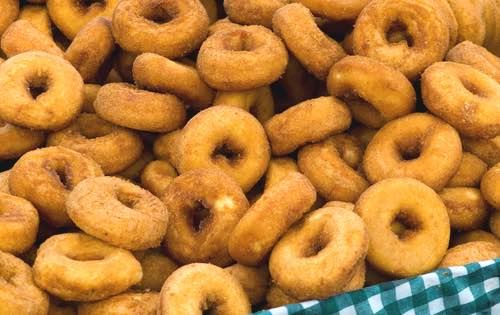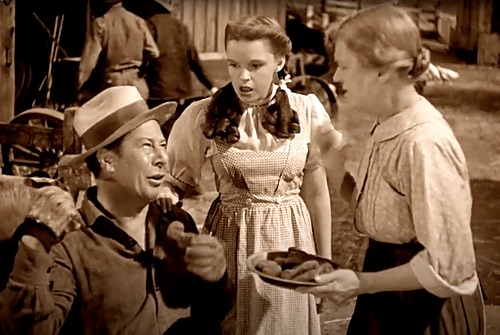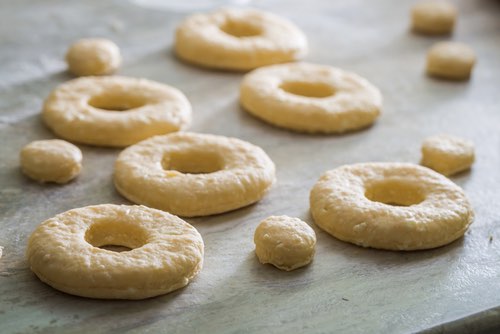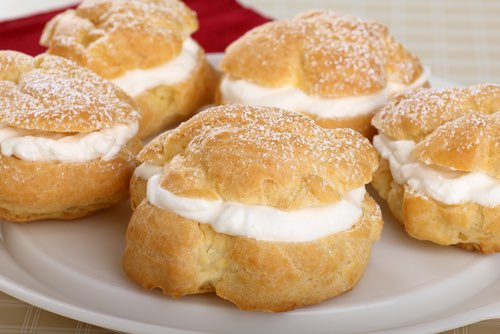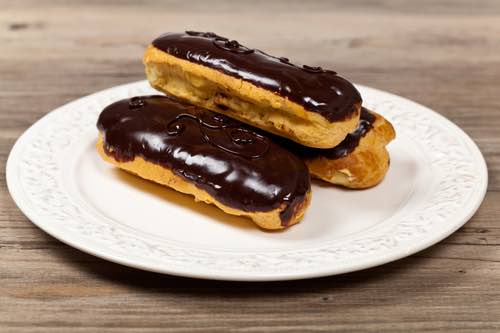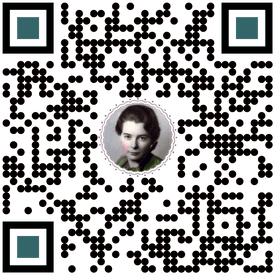- Home
- Donuts & Pastry
- Deep Fried Donut Recipes
Deep Fried Donut Recipes
These deep fried donut recipes from Grandma's recipe collection will transport you back to simpler times when homemade treats were made with love and basic ingredients. From classic sugar-dusted rings to jam-filled delights, you will discover authentic vintage recipes once enjoyed in homes across America — and even the White House!
Whether you find yourself craving old-fashioned donuts, German-style treats, or unique puffballs, these time-tested recipes produce crispy, golden-brown donuts that are impossible to resist. Get ready to create warm, fresh-from-the-fryer donuts that will fill your kitchen with nostalgic aromas and bring smiles to faces young and old.
Mom's Deep Fried Donut Recipes
Mom's Recipe Scrapbooks (c. 1920s)
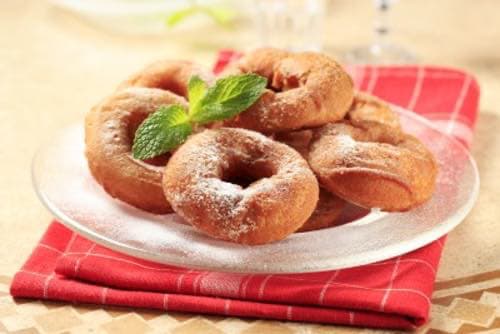 Mom's Easy Deep Fried Donuts
Mom's Easy Deep Fried Donuts(Source: ©tobi/123RF.com)
Mom's Easy Donuts
I know you'll love Mom's Easy Donuts. The good news is these old fashioned-style donuts really are EASY to make!
One of my fondest childhood memories was helping Mom to cut them out and then watch as she fried them in the hot lard.
You will take pride when serving such a crispy, tasty treat to your friends and loved ones, especially when you made it yourself.
1 Egg, 1 cup milk, 1-1/3 cups sugar, 2 teaspoonfuls cream of tartar, 1 teaspoonful baking soda, piece of butter the size of a walnut, 1/4 teaspoonful cinnamon (or nutmeg), pinch of salt, and flour enough to roll soft.
Method:
Beat the egg and sugar together and add the milk and butter. Stir the soda and cream of tartar into the flour, dry; mix all together, with the flour and salt. Roll and cut into doughnut rings, and fry in deep fat. Lay them on brown paper to cool when you take them from the fat.
Eat them plain or sprinkle with granulated sugar if desired. Enjoy them while they are warm and fresh.
Easy Plain Donuts
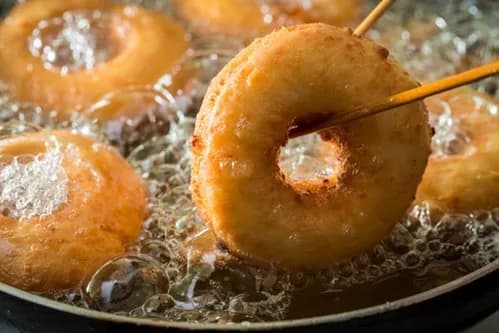 Wooden Skewers Help to Turn Donuts When Frying
Wooden Skewers Help to Turn Donuts When Frying(Source: ©Shaiith79/Depositdonuts.com)
This deep fried donut recipe is from a vintage Canadian newspaper clipping found in Mom's scrapbook. Recipes such as this were quite popular in many kitchens in the 1920s.
One egg, one cup of sugar, two tablespoons of butter, beaten together till creamy. Add one cup of sweet milk, a pinch of salt, two teaspoons of baking powder stirred into two cups of flour. Add one-half teaspoon of ginger and one-fourth teaspoon of nutmeg to the flour.
Beat well, roll out about one-fourth of an inch thick. Cut out all the cakes before beginning to fry. Cook in deep fat that will fry a small walnut-sized ball of the dough in about sixty-five seconds. Do not let the fat get above that degree of heat.
Quick and Simple Donuts
One teaspoonful of soda, two cups of sugar, three spoonfuls cream of tartar, one pint of milk, and flour enough to roll them out in. Fry in hot lard, as also the proceeding. —Mrs. Goodfellow's Cookery
Rhyming Donuts
One cup of sugar, 1 cup of milk;
Two eggs, beaten, as fine as silk;
Salt and Nutmeg, (lemon 'll do);
Baking powder, teaspoons two;
Lightly stir the flour in,
Roll on pie-board — not too thin,
Cut in diamonds, twists or rings,
Drop with care the doughy things,
Into fat that briskly swells,
Evenly the spongy cells,
Fry them brown, just short of burning,
Watch with care the time for turning,
Roll in Sugar, Eat when cool,
Price a quarter for this rule. —Sara E. Zook
Fruity Fried Donuts
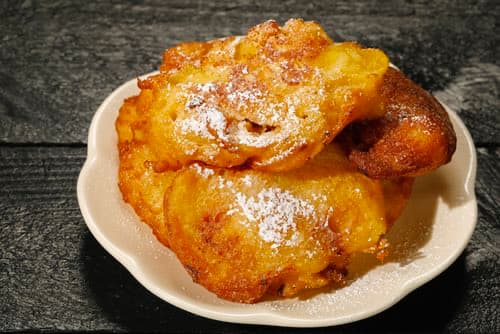 You'll Love These Fruity Fried Donut Treats
You'll Love These Fruity Fried Donut Treats(Source: ©marek_usz/Depositphotos.com)
Here's a great idea for a donut-style treat. Use your favorite deep fried donut recipes, but instead of cutting donut shapes, take bits of the dough and wrap them around pieces of fruit. Apple slices and berries are totally delicious inside a Fruity Fried Donut!
Raspberry Jam Filled Donuts
There's something especially appealing about this Canadian deep fried donut recipe. Just reading about these jam-filled-treats makes your mouth water. Any flavor of jam would be delicious in them.
Take the same mixture as for plain doughnuts, roll it out rather thinly and stamp into rounds, put a little raspberry jam, or your favorite flavor of jam, on half the rounds, brush the edges with water and cover with the remainder, press them firmly together and fry in hot fat five minutes. Sprinkle with sugar. —Cookery (1885)
Old Time Nutmeg Donuts
Sugar, 1 cup; butter, 1/2 cup; 4 eggs; flour, 3-1/2 cups; milk, 1 cup; cream of tartar, 2 teaspoonfuls; soda, 1 teaspoonful; salt, 1 teaspoonful; nutmeg, to taste.
Directions: Beat sugar and eggs together, with the cream of tartar and butter in the flour; dissolve the soda in the milk, then add it to the eggs and sugar, then the flour; roll out thin, cut and fry in hot lard. —Dr. Chase's Third, Last and Complete Receipt Book (1891)
White House Deep Fried Donut Recipes
The White House Cook Book (1913)
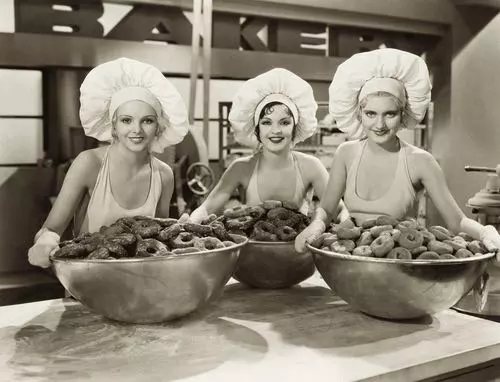 Everybody Loves Old Fashioned Donuts – Make Lots
Everybody Loves Old Fashioned Donuts – Make Lots(Source: ©everett255/Depositphotos.com)
Just imagine. The recipe for homemade donuts below was once used by the White House kitchen staff to make donuts for presidents!
German-Style Donuts
One pint of milk, four eggs, one small tablespoonful of melted butter, flavoring, salt to taste; first boil the milk and pour it, while hot, over a pint of flour; beat it very smooth and when it is cool have ready the yolks of the eggs well beaten; add them to the milk and flour, beaten well into it, then add the well-beaten whites; then, lastly, add the salt and as much more flour as will make the whole into a soft dough.
Flour your board, turn your dough upon it, roll it in pieces as thick as your finger and turn them in the form of a ring; cook in plenty of boiling lard. A nice breakfast cake with coffee.
Old Time Puffball Donuts
This old deep fried donut recipe makes a tasty treat similar to what many of us now call Donut Holes. You will enjoy these!
Three eggs, one cupful of sugar, a pint of sweet milk, salt, nutmeg and flour enough to permit the spoon to stand upright in the mixture; add two heaping teaspoonfuls of baking powder to the flour; beat all until very light.
Drop dough by the dessertspoonful into boiling lard. These will not absorb a bit of fat and are not at all rich, and consequently are the least injurious of this kind of cakes. These puffball-style donuts, eaten fresh and warm, are a delicious breakfast dish and are quickly made.
Deep Fried Donut Recipe
A New Book of Cookery (1912)
Cheap CRISPY Donuts
This old fashioned doughnut recipe calls for dipping the fried doughnuts quickly into boiling water immediately after they've been fried in oil or lard.
This unique method for frying donuts would likely remove any surface fat making them less greasy and possibly crisper. It's a method also published in Fannie Merritt Farmer's 1912 cookbook.
4 cups flour
1 cup sugar
2 teaspoons cream of tartar
1 teaspoon soda
1 teaspoon salt
1/2 nutmeg, grated
2 eggs
3/4 cup milk
Mix and sift dry ingredients, add eggs, well beaten, and milk, the amount required being about three-fourths cup, sometimes more but never as much as a cup. Toss on a slightly floured board, pat, roll, shape, and fry.
Remove doughnuts from fat, using a two-tined fork, and pass quickly through water kept at the boiling point. The fork must be wiped each time before putting into fat.
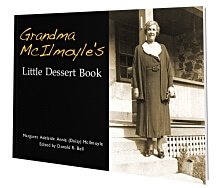
Sign Up now for GRANDMA'S DESSERT CLUB and download your FREE PDF COPY of Grandma McIlmoyle's Little Dessert Book. Also receive my regular Bulletin featuring classic recipes and nostalgia.

